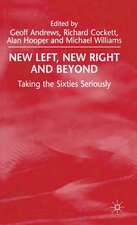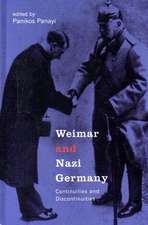Researching Local History: The Human Journey: Approaches to Local History
Autor M. Williamsen Limba Engleză Paperback – 18 iul 1996
| Toate formatele și edițiile | Preț | Express |
|---|---|---|
| Paperback (1) | 432.87 lei 6-8 săpt. | |
| Taylor & Francis – 18 iul 1996 | 432.87 lei 6-8 săpt. | |
| Hardback (1) | 1001.55 lei 6-8 săpt. | |
| Taylor & Francis – 9 feb 2015 | 1001.55 lei 6-8 săpt. |
Preț: 432.87 lei
Nou
Puncte Express: 649
Preț estimativ în valută:
82.83€ • 88.57$ • 69.06£
82.83€ • 88.57$ • 69.06£
Carte tipărită la comandă
Livrare economică 17 aprilie-01 mai
Preluare comenzi: 021 569.72.76
Specificații
ISBN-13: 9780582042889
ISBN-10: 0582042887
Pagini: 296
Dimensiuni: 138 x 216 x 17 mm
Greutate: 0.38 kg
Ediția:1
Editura: Taylor & Francis
Colecția Routledge
Seria Approaches to Local History
Locul publicării:Oxford, United Kingdom
ISBN-10: 0582042887
Pagini: 296
Dimensiuni: 138 x 216 x 17 mm
Greutate: 0.38 kg
Ediția:1
Editura: Taylor & Francis
Colecția Routledge
Seria Approaches to Local History
Locul publicării:Oxford, United Kingdom
Cuprins
Chapter 1. The Why and How of Studying History.
Chapter 2. Given in Evidence.
Chapter 3. That Which is Written.
Chapter 4. Notes, Notebooks and Archives.
Chapter 5. One Society at One Particular Time: Caerleon in the Great War.
Chapter 6.The Matter of Polulation.
Chapter 7. Labelled for Posterity: Using Surnames as Tracers of Family Movement.
Chapter 8.Tracing the Welsh.
Chapter 9. Getting it Together.
Chapter 10. But What is it All For?
Further Reading
Chapter 2. Given in Evidence.
Chapter 3. That Which is Written.
Chapter 4. Notes, Notebooks and Archives.
Chapter 5. One Society at One Particular Time: Caerleon in the Great War.
Chapter 6.The Matter of Polulation.
Chapter 7. Labelled for Posterity: Using Surnames as Tracers of Family Movement.
Chapter 8.Tracing the Welsh.
Chapter 9. Getting it Together.
Chapter 10. But What is it All For?
Further Reading
Descriere
This practical book provides a fascinating - and often moving - account of Professor Williams' adventures into the past of his own family and community. He demonstrates local history methodology through his research into ancestry, migration, work, war and religion in the towns and villages of England and Wales. Richly illustrated throughout.























